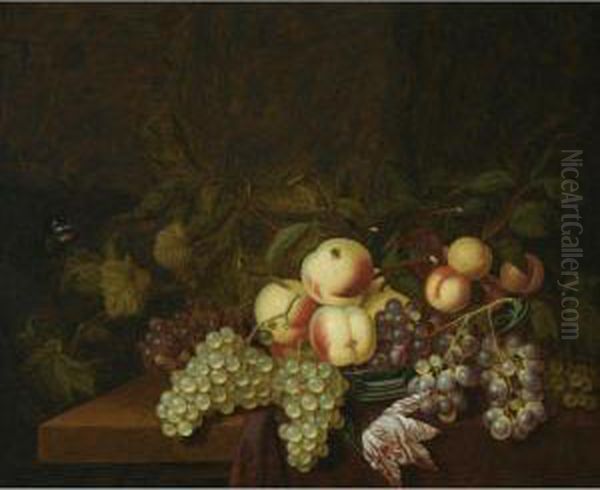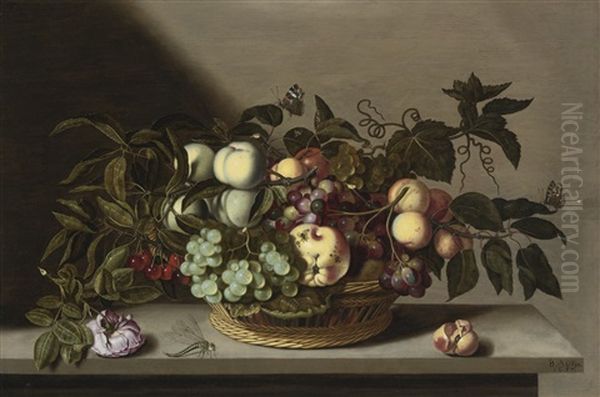
Bartholomeus Assteyn stands as a notable figure in the rich tapestry of Dutch Golden Age painting, a period renowned for its extraordinary artistic output and the rise of specialized genres. Active primarily in his native Dordrecht, Assteyn carved a niche for himself as a painter of exquisite still lifes, particularly those featuring arrangements of fruit and flowers. His work, while perhaps not as universally recognized today as some of his contemporaries, embodies the technical skill, keen observation, and aesthetic sensibilities that defined this remarkable era in art history.
Early Life and Artistic Formation in Dordrecht
Born in Dordrecht around 1607, Bartholomeus Assteyn (sometimes spelled Assesteijn) entered a world where the Netherlands was experiencing unprecedented economic prosperity and cultural flourishing. Dordrecht, one of the oldest cities in Holland, had a vibrant artistic community. While specific details about Assteyn's early training are scarce, as is common for many artists of this period, his stylistic affinities strongly suggest connections to the influential Bosschaert dynasty of still-life painters.
It is highly probable that Assteyn received instruction or was significantly influenced by artists working in the tradition established by Ambrosius Bosschaert the Elder (1573–1621), a pioneering figure in Dutch flower painting. Bosschaert, who worked in Middelburg and later Utrecht, had a profound impact on the genre. His sons, Ambrosius Bosschaert the Younger, Abraham Bosschaert, and Johannes Bosschaert, continued his legacy. Another key figure in this circle was Balthasar van der Ast (1593/94–1657), Ambrosius the Elder's brother-in-law and pupil, who also specialized in detailed still lifes of flowers, fruits, and shells. Given that Van der Ast worked in Utrecht and later Delft, and Assteyn was primarily active in Dordrecht, any direct tutelage would have involved travel or a period of residence outside his hometown, or influence through disseminated works and shared artistic circles. Assteyn joined the Dordrecht Guild of Saint Luke in 1631, a formal indication of his status as an independent master.
The Signature Style of Bartholomeus Assteyn

Assteyn’s oeuvre is characterized by a meticulous attention to detail, a vibrant yet harmonious color palette, and compositions that, while often seemingly simple, are carefully constructed for balance and visual appeal. His primary subjects were fruit and flowers, often arranged in baskets, on stone ledges, or in simple ceramic or glass vessels. Like many still-life painters of his time, he demonstrated an acute ability to render different textures, from the velvety softness of a peach to the delicate translucency of grape skins and the crispness of flower petals.
Early works by Assteyn sometimes show a more symmetrical and somewhat rigid compositional structure, a trait shared with the earlier works of the Bosschaert school. Objects are often laid out with clarity, each given its due prominence. Over time, his compositions appear to have gained a degree of dynamism and a more naturalistic arrangement, though he generally maintained a sense of order and elegance. The inclusion of insects—butterflies, caterpillars, flies, or beetles—was a common motif in Dutch still lifes, and Assteyn incorporated these into his works. These creatures could carry symbolic meanings, alluding to the transience of life and beauty (vanitas), or simply serve as a testament to the artist's skill in depicting minute details of the natural world.
His lighting is typically clear and even, illuminating the subjects to highlight their colors and forms. He often favored a dark, neutral background, which served to make the brightly colored fruits and flowers stand out dramatically. This technique was common among still-life painters as it enhanced the three-dimensionality and tactile quality of the objects depicted.
Notable Works and Their Characteristics
One of Assteyn's well-documented and representative works is a "Still Life with Fruit in a Wicker Basket, with a Butterfly, Caterpillar, and Other Insects on a Stone Ledge." A particularly fine example, dated 1631, was sold at Christie's, London. This painting showcases many of his hallmark characteristics: a centrally placed basket overflowing with grapes, peaches, plums, and cherries, rendered with exquisite detail. The various insects are scattered around the composition, adding life and a touch of naturalism. The textures of the fruit, the wicker of the basket, and the cool smoothness of the stone ledge are all convincingly portrayed.
Other paintings depict bouquets of flowers, such as tulips, roses, irises, and carnations, often arranged in simple vases. These floral pieces also demonstrate his keen observational skills and his ability to capture the delicate beauty of each bloom. The choice of flowers often reflected those that were highly prized and sometimes exotic in the 17th-century Netherlands, such as the tulip, which had famously caused an economic bubble known as "Tulip Mania" in the 1630s.

While Assteyn may not have produced a vast number of works compared to some of his contemporaries, the consistency in quality and style across his known paintings speaks to a dedicated and skilled practitioner of the still-life genre. His signature, often "B. Assteyn," and dates on his paintings help in their attribution and in tracing his active period, which seems to extend from the early 1630s to at least the late 1660s, with some sources suggesting activity up to 1677. He is recorded as deceased by 1677, though some records suggest he may have died as early as 1669.
Assteyn in the Context of the Bosschaert Dynasty and Dordrecht School
Bartholomeus Assteyn is best understood as an inheritor and practitioner of the stylistic traditions established by the Bosschaert family and Balthasar van der Ast. This "school" or tradition was characterized by its detailed realism, bright colors, and often symmetrical compositions, especially in its earlier phases. Ambrosius Bosschaert the Elder was a foundational figure, and his influence, along with that of Van der Ast, radiated outwards, impacting many artists.
Assteyn’s work shares the meticulous detail and jewel-like quality found in the paintings of these artists. The careful arrangement of objects, the rendering of light and texture, and the inclusion of insects are all features that link him to this influential group. While he was based in Dordrecht, the artistic currents of the time flowed between cities, and the popularity of still-life painting ensured a shared vocabulary of motifs and techniques.
Within Dordrecht itself, Assteyn was part of a thriving artistic community. Other notable painters active in Dordrecht during parts of Assteyn's lifetime included the renowned portrait and genre painter Jacob Gerritsz. Cuyp (1594–1652) and his even more famous son, the landscape painter Aelbert Cuyp (1620–1691). Samuel van Hoogstraten (1627–1678), known for his perspective boxes, portraits, and genre scenes, also hailed from Dordrecht, as did Nicolaes Maes (1634–1693), a pupil of Rembrandt who later specialized in portraiture. Another Dordrecht still-life painter, though of a slightly different style focusing more on "ontbijtjes" (breakfast pieces), was Paulus Lesire (1611-1656). While their primary genres often differed, the presence of such accomplished artists contributed to a rich artistic milieu in the city.
Interactions and Comparisons with Contemporaries
The Dutch Golden Age was populated by a remarkable number of talented painters. Arnold Houbraken, in his "De groote schouburgh der Nederlantsche konstschilders en schilderessen" (The Great Theatre of Dutch Painters and Paintresses, 1718–1721), provides an interesting contemporary, or near-contemporary, perspective. Houbraken mentions Bartholomeus Assteyn, noting that his flower pieces were as popular and esteemed as the "Boerekermisstuk" (peasant fair pieces) of Joost Cornelisz. Droochsloot (1586–1666). Droochsloot was primarily active in Utrecht and known for his lively village scenes and landscapes with numerous figures, a genre quite different from Assteyn's serene still lifes. Houbraken's comparison suggests that Assteyn had achieved a significant reputation and that his specialized works found a ready market, comparable in appeal to other popular genres.
Droochsloot himself was influenced by earlier Flemish traditions, particularly the work of Pieter Bruegel the Elder, and by contemporaries like David Vinckboons and Esaias van de Velde. While Assteyn’s direct artistic lineage points more towards the Bosschaert school, the broader artistic environment of the Netherlands was interconnected, with artists often aware of developments in other cities and genres.
Beyond Dordrecht and Utrecht, the still-life genre was flourishing elsewhere. In Haarlem, painters like Willem Claesz. Heda (1594–1680) and Pieter Claesz. (1597–1660) were masters of the "monochrome banketje," subtle arrangements of tableware and food rendered in muted tones. In Antwerp and later Utrecht, Jan Davidsz. de Heem (1606–1684) created opulent still lifes, often more elaborate and dynamic than Assteyn's, filled with luxurious objects, fruits, and flowers. Willem Kalf (1619–1693), active in Amsterdam, was renowned for his "pronkstilleven" (ostentatious still lifes), showcasing precious glassware, Chinese porcelain, and exotic fruits. Later in the century, artists like Rachel Ruysch (1664–1750) and Jan van Huysum (1682–1749) would take flower painting to new heights of complexity and decorative elegance. Assteyn’s work, by comparison, often retains a certain charming directness and intimacy.
Artistic Legacy, Collections, and Art Historical Considerations
Bartholomeus Assteyn’s paintings are held in various public and private collections, primarily in Europe. The Dordrechts Museum, in his native city, possesses examples of his work, which is fitting. The Rijksmuseum in Amsterdam also includes his paintings, acknowledging his place within the broader narrative of Dutch art. His works also appear periodically on the art market, attesting to a continued appreciation among collectors of Dutch Golden Age still lifes.
An interesting, though modern, art historical note involves a study on gender bias in art valuation. In this study, participants were shown pairs of paintings, one by a male artist and one by a female artist of comparable skill and period. When the artists' genders were revealed, participants often valued the male artist's work more highly. One such pairing reportedly involved a work by Assteyn and one by Judith Leyster (1609–1660), a highly skilled contemporary from Haarlem. This anecdote, while reflecting modern biases rather than historical ones from Assteyn's time, underscores the complex factors that can influence artistic reputation and market value over centuries. It highlights how figures like Assteyn, while respected, might be evaluated differently when juxtaposed with artists whose narratives have been shaped by different historical and social dynamics.
The primary legacy of Bartholomeus Assteyn lies in his contribution to the Dutch still-life tradition. He was a skilled practitioner who absorbed the influences of his artistic milieu, particularly the Bosschaert school, and developed a recognizable style characterized by clarity, vibrant color, and meticulous detail. His paintings offer a window into the 17th-century Dutch appreciation for the beauty of the natural world, the allure of carefully arranged objects, and the technical prowess of the artist.
His works, like those of many of his contemporaries such as Osias Beert (c. 1580–1623) or Jacob van Hulsdonck (1582–1647) who worked in a similar detailed manner, catered to a burgeoning middle-class and wealthy merchant class eager to adorn their homes with art. These paintings were not just decorative; they often carried layers of meaning, reflecting on wealth, the bounty of nature, the passage of time, and sometimes, subtle moral or religious messages.
Concluding Thoughts on Bartholomeus Assteyn
Bartholomeus Assteyn may not have been a radical innovator in the vein of Rembrandt or Vermeer, but his contribution to the Dutch Golden Age is significant within his chosen specialization. He represents the depth and breadth of artistic talent that characterized this period, where numerous artists achieved a high level of skill and produced works of enduring beauty. His fruit and flower still lifes are a testament to the Dutch love for the observable world, rendered with a precision and charm that continue to appeal to viewers today.
As an art historian, it is important to recognize the contributions of artists like Assteyn who formed the backbone of specific genres. They maintained high standards of craftsmanship, responded to the tastes of their patrons, and collectively created a visual culture of extraordinary richness. Assteyn’s paintings, with their carefully depicted fruits, lustrous flowers, and attendant insects, invite close looking and offer a quiet, contemplative beauty—a valuable legacy from the bustling artistic world of 17th-century Dordrecht. His place, though perhaps modest when compared to the giants of the era, is secure as a fine exponent of Dutch still-life painting.